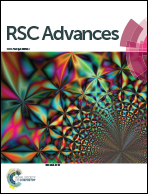A highly sensitive chlorine gas sensor and enhanced thermal DC electrical conductivity from polypyrrole/silicon carbide nanocomposites
Abstract
In this communication, we report the synthesis of polypyrrole (PPy) and polypyrrole/silicon carbide nanocomposites (PPy/SiC) and PPy/SiC/dodecylbenzenesulfonic acid (DBSA) by an in situ chemical polymerization method and their application as a sensor for the detection of highly toxic chlorine gas. The as prepared PPy, PPy/SiC and PPy/SiC/DBSA nanocomposites were confirmed by Fourier transform infrared spectroscopy, thermogravimetric analysis, X-ray diffraction, field emission electron microscopy and transmittance electron microscopy technique. The PPy/SiC/DBSA nanocomposite was found to possess higher DC (direct current) electrical conductivity as compared to that of PPy and PPy/SiC. The sensing response was determined on the basis of change in DC electrical conductivity. The response of PPy and both of the nanocomposites, was found to be highly sensitive and reversible to chlorine gas. This study seems to be promising as an effective approach towards the sensing technology for the detection of chlorine gas.


 Please wait while we load your content...
Please wait while we load your content...